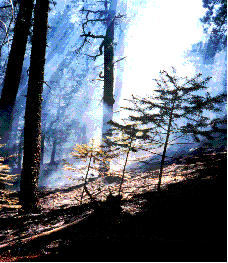Laboratory
|

Prescribed fire on Mt. Lemmon, near Tucson. Photo by Henri Grissino-Mayer. |
A management strategy for re-introducing fire back into forest ecosystems of the Southwest is to set fires intentionally under strictly controlled conditions. This strategy has been called prescribed burning.
- Click here for a citeable definition of prescribed burning.
- 423 acres to burn on purpose in Rincons. This 2010 Arizona Daily Star article discusses a prescribed burn for the Rincon Mountains, just east of UA campus.
- Burning our forests is the best way to save them: This 2009 Arizona Daily Star article promotes prescribed burning to re-introduce fire into SW forests.
-
Babbitt starts bid to fight fire with fire using prescribed
burns: This 1997 Arizona Daily Star article describes
management plans of the Secretary of Interior, Bruce Babbitt, who
proposed increased prescribing burning to reduce hazardous levels
of fuel in forests. Babbitt also comments on alternative
proposals to using forest harvesting to reduce fuel loading.
- Forest
Service plans to set fire by Summerhaven: This 1998 Arizona Daily Star
article describes plans to intentionally start a fire near the top of Mount Lemmon,
just north of Tucson. An example to cite.
- 17,000
Arizona, New Mexico acres to be burned on purpose: This 1997
Arizona Daily Star article describes plans and reasons for
a relatively large prescribed burn along the Arizona-New Mexico
border. Lots of citeable nuggets here.
-
Maverick fire meets goals, burns nearly 11,000 acres: This 1997 Arizona
Daily Star article discusses the large prescribed burn mentioned in the previous
article above; it also discusses the ecological and management objectives.
- Burn
and let burn: This 1994 Arizona Daily Star editorial
comment argues for a change in fire management policies, from
complete and total fire suppression to a strategy that includes
prescribed burning and let burning.
- Collins, B.M.; Stephens, S.L.; Moghaddas, J.J.; Battles, J. 2010. Challenges and approaches in planning fuel treatments across fire-excluded forested landscapes. Journal of Forestry 108(1):24-31: This 2010 Journal of Forestry article talks about fuel treatment options, including advantages and disadvantages.
What happens when prescribed fires go out of control? In May,
2000, National Park Service authorities started a prescribed burn
in Bandelier National Monument, New Mexico (just southwest of
Santa Fe on the
fire sites map). Soon after it was started, the fire went out
of control because of high winds. The wildfire lasted several
days and burned thousands of acres, including parts of the town
of Los Alamos, destroying much property and threatening the
national laboratory that exists there. Below are some articles
describing that unfortunate event:
- Los Alamos fire
offers a lesson in humility: This 2000 High Country News article
duscusses the Los Alamos fire, prescribed but then lost out of control.
- Town
draws a breath: This 2000 Arizona Daily Star article describes the human
impact of the Los Alamos fire.
-
Babbitt shuts off prescribed fires in West for 30 days: This 2000 Arizona
Daily Star article describes the reaction of the Secretary of the Interior,
Bruce Babbitt, which was to stop, at least momentarily, all prescribed burning in federal forests.
Citeable info about theory of prescribed burning.
- Colorado governor halts prescribed
burning: This 2012 Arizona Daily Star article describes the Colorado governor
halting, at least momentarily, prescribed burning in state forests.
Another related management strategy for re-introducing fire back into forest ecosystems of the Southwest is to let natural fires continue burning under controlled conditions. This strategy has been called "let burning."
Read on for an example of let burning:- Forest
fires spreading in New Mexico; officials allow burns to clear overgrowth:
This Arizona Daily Star 1997 article describes a Forest Service decision not to
suppress a wildfire, but rather to let it burn to meet various management objectives.
Laboratory of Tree-Ring Research, University of Arizona
Tucson, Arizona 85721 USA
Main Office: (520) 621-1608, Fax: (520) 621-8229
Comments to Paul Sheppard: sheppard @ ltrr.arizona.edu
Copyright © 2000-2012, Laboratory of Tree-Ring
Research, University of Arizona
Revised — April, 2012
URL:
http://www.ltrr.arizona.edu/~sheppard/swland/startfires.html